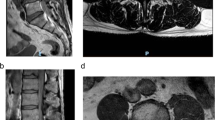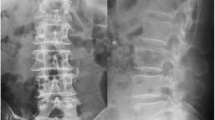Abstract.
Posterior epidural migration (PEM) of free disc fragments is rare, and reported PEM patients usually presented with radicular signs. An uncommon case involving a patient with cauda equina syndrome due to PEM of a lumbar disc fragment is reported with a review of the literature. The patient described in this report presented with an acute cauda equina syndrome resulting from disc fragment migration at the L3–L4 level that occurred after traction therapy for his lower back pain. The radiological characteristics of the disc fragment were the posterior epidural location and the ring enhancement. A fenestration was performed and histologically confirmed sequestered disc material was removed. An early postoperative examination revealed that motor, sensory, urological, and sexual functions had been recovered. At late follow-up, the patient was doing well after 18 months. Sequestered disc fragments may occasionally migrate to the posterior epidural space of the dural sac. Definite diagnosis of posteriorly located disc fragments is difficult because the radiological images of disc fragments may mimic those of other more common posterior epidural lesions.
Similar content being viewed by others
Author information
Authors and Affiliations
Additional information
Electronic Publication
Rights and permissions
About this article
Cite this article
Dösoğlu, M., Is, M., Gezen, F. et al. Posterior epidural migration of a lumbar disc fragment causing cauda equina syndrome: Case report and review of the relevant literature. Eur Spine J 10, 348–351 (2001). https://doi.org/10.1007/s005860100300
Received:
Revised:
Accepted:
Published:
Issue Date:
DOI: https://doi.org/10.1007/s005860100300




